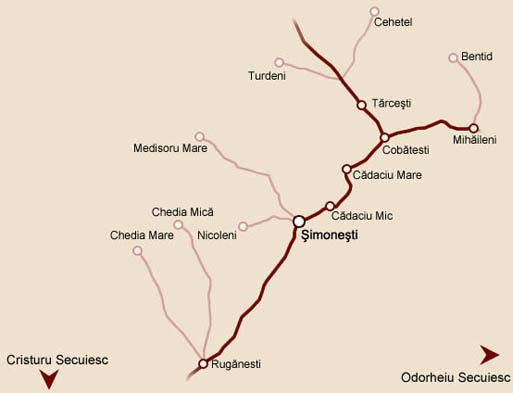- Welcome to the home page of Simonesti
This home page gives you new and succinct information about the village that is the administrative center of 14 other villages. It is found right in the center of Kereszturszek, beside the flow of the “blonde” stream, the Nyiko. The little settlements have that own specific style and atmosphere of the Szekely villages in spite of the storms they went through the flow of history. This is something very precious in a society that homogenizes culture. The little houses are well taken care of, the specific Szekely gates still have a seat below them, the gardens in front of the houses are full of flowers and the inhabitants honor the traditions.
Reading through this home page we can find out where these villages lie, how many inhabitants they have, touristic sights in the villages, their culture, fellowship connections and what problems they confront in everyday life.
- Map

- Historical and geographical characteristics
The region beside the flow of the Feher Nyiko is in between the Madarasi Hargita and the Fogarasi mountains. But here the mountains turn into hills. The highest points are: Firtosteto (1602 m), Lazhely (1009 m), Szilas (986m), Gordon (845m), Kalanda (845m), Rez (932m), Varhegy (824m).
In this region there are 23 settlements grouped in two villages. To Şimoneşti belong Ceheţel, Turdeni, Tărceşti, Benţid, Mihăileni, Medişoru Mare, Chedia mică, Chedia Mare, Cobăteşti, Nicoleşti, Cădaciu Mic, Cădaciu Mare, Rugăneşti. These settlements lie beside the middle and the lower flow of the Nyiko.
From an administrative point of view they belong to Hargita county. Its territory is about 11,618 hectares, but the map doesn’t show it as distinct region.
- Demographic dates
The village has 3739 inhabitants, of them 3705 are Hungarians, 32 Romanians and one Swabian. After the Catholicism of the Middle Ages, the inhabitants had become Unitarian in general, a religion founded by David Ferenc. The dominant religion is the former, but there live people having other religions, too, for example, Roman-Catholics, Reformed, Orthodoxies, Lutherans, Baptists, etc.
- Touristic sights
The terrain of the region is really beautiful and gives the eye of a tourist something delightful to see. The one who like fishing can find fish ponds, the one who like walking or mountain climbing can visit the highest peaks surrounded by streams, woods, valleys. The one with health problems can take mud-cures.
If someone is interested in the history of this nation there are churches and old mansions built especially in the style of the Middle Ages.
- Economic and cultural life
The main occupation of the inhabitants is agriculture. In some places people grow vegetables and fruits, too. From the branches of the small scale industry characteristic to this region is wood shaping and basket making. Basket making was brought into the region by Szasz Ferenc teacher in the early 1900 years.
Cultural activity had always been in the hand of teachers and ministers who organized different events so that cultural life was lively and tradition was preserved. Nowadays because of the depopulation of the region and the heavy migration cultural life is very poor but there are various tries to restore it.
- Fellowship connections
Not all of the villages have twin villages, but the all of the Unitarian communities have fruitful connection with communities all over the U.S. within the programme that was started with the help of Dr.Gellerd Judit

